White House Protests Film’s Use of Clinton
- Share via
WASHINGTON — It might be OK to use special effects to depict the fictional Forrest Gump offering to flash a scar on his rear to former President Lyndon B. Johnson, but the White House said Monday it believes Hollywood took creative license too far in a new movie showing President Clinton purportedly commenting on communication from aliens.
Technology advances have made it possible to blend fiction and reality in surprisingly believable new ways. But in the case of Warner Bros.’ star-studded summer movie “Contact,” White House counsel Charles F.C. Ruff argues that the filmmakers overstepped the bounds of propriety.
Ruff complained in a letter to the film’s director, Robert Zemeckis, that the movie used Clinton’s “image and words” in a way that was “fundamentally unfair” and broke White House policy by using the president for a commercial purpose. “Contact” opened Friday and grossed $20.6 million during the weekend, second only to the take of another alien flick, “Men in Black.”
The president is the brunt of endless satire on late-night television, including photos and other characterizations of him and White House spokesman Mike McCurry conceded Monday that this is protected by the 1st Amendment.
Clinton’s unwilling role in “Contact,” however, is another matter because the president’s image, “which is his alone to control, is used in a way that would lead a viewer to imagine that he had said something that he didn’t really say,” McCurry said.
*
But beyond voicing objections, White House officials said they would take no legal action to try to prevent use of the images. The point, they said, was to signal that they they would not like to see this done again in another movie.
In the movie, Clinton is seen talking to reporters in the White House briefing room about the importance of communications from aliens. In reality, Clinton’s comments were about exciting findings made earlier this year about possible life-forms on Mars, and they were made in the White House Rose Garden.
At another point in the movie, Clinton addresses Americans trying to calm and assure them that all efforts are being made to investigate an unexplained explosion. In reality, the president made the comments about events in Iraq.
In another scene--with the help of technology--Clinton is shown in the White House Cabinet room with two actors, James Woods, who plays the national security advisor, and Tom Skeritt, in the role of the head of the National Science Foundation.
And if fiction and reality weren’t blurred enough, a bunch of real-life CNN reporters play themselves in the movie.
Former White House spokeswoman Dee Dee Myers, a consultant to the film, alerted the White House weeks ago about the president’s role in “Contact,” Myers and White House officials said.
Zemeckis was reported on vacation and unavailable for comment.
But Myers said, “Zemeckis believed correctly he was on safe legal ground.” She said she informed the White House merely as a courtesy.
Steve Starkey, the producer, said Clinton and other recognizable people were used in the movie to lend realism and immediacy to the drama and make viewers confront the question: What would happen if?
“It worked if people feel that the movie feels real because of his presence and the presence of other familiar faces in the movie,” Starkey said. “It is a fictional piece after all . . . taken as such, it is truly harmless.”
This is not the first time Zemeckis morphed reality into fiction. In his blockbuster movie “Forrest Gump,” Zemeckis used high-tech trickery to place the hapless, but lovable, character, played by Tom Hanks, in various historical events meeting famous people, like Johnson.
Myers, who was Clinton’s spokeswoman early in his first term, said that although she was not asked her opinion, she did not think the president would mind.
“I certainly wasn’t uncomfortable with the way they used the president’s image,” she said. “It’s clear that it’s fiction and his words--while taken out of contest--are not manipulated and they’re respectful.”
Myers said that because of the high-tech deception used by the filmmakers, the movie “raises some larger questions.”
Although in this case Clinton’s comments were characteristic, Myers said, in another instance a movie could use an historical figure’s words out of context to create an illusion that contradicts the essence of the person, which would be more troublesome.
Robert Rosen, the chair of the School of Film and Television at UCLA, said he does not believe the film goes too far and urged the White House not to “worry about it.”
*
“The White House should have a little bit more confidence in the intelligence of the people who go to see movies--they’re able to discern fiction from reality,” Rosen said.
And although the White House sent the letter, several White House officials stressed that no one was sitting around 1600 Pennsylvania Ave. concerned about whether Americans would believe the movie.
Clearly times have changed.
More than a half-century ago, President Franklin D. Roosevelt appeared in numerous newsreels. But when studios attempted to use the footage in feature films, including Joe E. Brown’s “Elmer the Great,” the president’s press secretary, Stephen T. Early, used his influence to prevent them from doing so out of concern for protecting the dignity of the office.
More to Read
Only good movies
Get the Indie Focus newsletter, Mark Olsen's weekly guide to the world of cinema.
You may occasionally receive promotional content from the Los Angeles Times.









